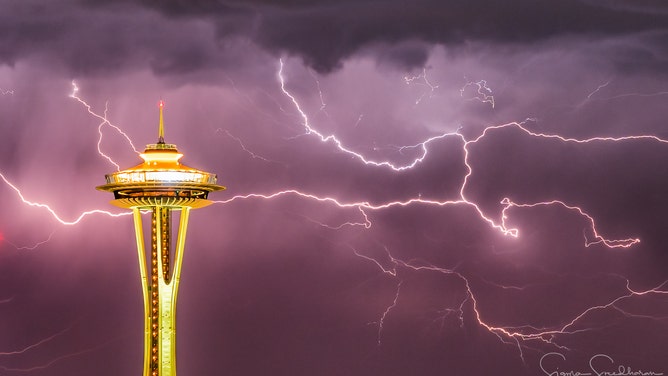Weekend Weather Wows: Michigan gets 4 feet of snow in May while East gets break from high pressure situations
Welcome to our weekly feature, "Weekend Weather Wows," where we'll go back and find the most exciting tidbits of weather you might have missed over the past week, so you'll be ready to impress at the water cooler (or virtual water cooler) come Monday.
Michigan officials work to cleanup record-breaking May snow
Michigan Department of Transportation Superior Region spokesperson Dan Weingarten joins FOX Weather to discuss how Michigan officials are working to clean up the late-season, record-breaking snow.
MARQUETTE, Mich. – It turns out you can even check the weather to get your daily dose of omega supplements…
Welcome to our weekly feature, "Weekend Weather Wows," where we'll go back and find the most exciting tidbits of weather you might have missed over the past week, so you'll be ready to impress at the water cooler (or virtual water cooler) come Monday.
This week, the Omega block stole the headlines for creating some shall-we-say "unusual" weather for being halfway through spring.
Nothing says 'it's May' like 4 feet of snow
Marquette is well familiar with "March Madness," but this week, it's more like "May Madness" as the town and much of Michigan's Upper Peninsula were hit with what might be termed an unfair amount of snow for being 7 weeks from summer. You could say Mother Nature gave them quite the come'UP'pance.

Heavy snow blankets Marquette, Michigan on May 1, 2023.
(Marquette Golf Club / FOX Weather)
The National Weather Service office in Marquette recorded 26.2 inches of snow from May 1-3 -- their all-time monthly snow record for May.
Nearby Herman, Michigan, did Marquette even better, recording 27 inches in one day on Tuesday, and 48 inches – yes, that's 4 FEET! – from May 1-3.
Tuesday's 27 inches was not only the snowiest May day in town; it's not only the snowiest May day in all of Michigan, but according to Alaska climatologist Brian Brettschneider, Herman's 27-inch snow day ranks as the snowiest May date for anywhere east of the Mississippi River. Take that, Detroit.
HISTORIC SNOWS IN MICHIGAN, WEST VIRGINIA BREAK STATEWIDE RECORDS
For Marquette, it brings their seasonal snowfall to 265.1 inches which sounds like it too should be a record until you realize this is northern Michigan and essentially a stone's throw from being in Canada. They've had a winter with 319.8 inches of snow just 22 years ago (or what Utah ski resorts this year call "brunch".)
Farther east, Snowshoe, West Virginia, managed to get 16 inches of snow out of the storm as it swept through the Appalachians. It too would have set a state record for May snowfall except nearby Canaan Mountain reached 16.2 inches to set the record.
We've got friends in low (pressure) places
The storm that moved up into New England on Monday not only brought heavy rains and flash flooding, but some record low atmospheric pressure readings for May.
Boston (983.6 mb), Hartford (981.5 mb), New York City (982.1 mb), Providence (983.6 mb) as well as Toronto (986.5), Ottawa (981.0 mb) and Montreal (981.2) all set record low pressure readings for May.
Virginia Beach suffers through its strongest tornado on record
Thunderstorms brought a rare sight to Virginia Beach Sunday: a strong tornado. A tornado later determined to be an EF-3 on the Enhanced Fujita Scale tore across about 4.5 miles of the city with winds estimated at around 145 mph.
Drone video shows devastation left across Virginia Beach from tornado
Drone video shot by the Virginia Beach Fire Department shows the devastation left across Virginia Beach from Sunday's tornado.
It's the first tornado in the city to reach an EF-3 status in Virginia Beach and the first anywhere in the state that strong since April 2019. It was the first tornado reported in Virginia Beach since an EF-2 touched down in March 2017, but the 15th tornado to strike the city since 1950.
Meanwhile, not one but two weak tornadoes touched down in the Los Angeles area on Thursday.
The pair of EF-0 tornadoes were the first May tornadoes in Los Angeles County since 1984.
Sudden damaging wind gusts in Seattle underscore gravity of freak situation
The pressure was considerably higher, then it wasn’t, then it was again around Seattle's Sea-Tac Airport early Tuesday morning as a freak event brought sudden wind gusts to 40-63 mph to a localized region in the dead of night.
Not only did wind gusts go from single digits to raging levels in minutes, but the wind direction also underwent radical shifts, from south to north back to south…back to north again all within two hours. Sea-Tac's 43 mph gust was the strongest May gust in 10 years, while a 63-mph gust recorded in nearby Normandy Park by Michael Snyder, another local meteorologist, was the strongest gust he's ever seen at his house, despite measuring years of wind storms.
Meanwhile, the atmospheric pressure dropped 13.2 millibars in 49 minutes, only to jump back up 9 millibars in just two minutes!
University of Washington Atmospheric Sciences Professor Cliff Mass analyzed the data suggesting it was a gravity wave that produced the quirky weather. He said Seattle was lucky the event occurred in the middle of the night when air traffic is minimal as such radically shifting winds and speeds could have wreaked havoc on approaching and departing flights.
Later that week, a bit more traditional sky chaos as seen from some of my photographer friends in the city:
Stop laughing, Florida
Lightning sensors monitoring Alaska's skies detected a thunderstorm on May 3, when a whopping 7 strikes of lightning were detected along the Dalton Highway near Finger Mountain, according to the National Weather Service in Fairbanks.
It brings Alaska's total lightning count in its interior for this spring to… 7.
Alaska doesn't get a lot of stark temperature changes needed for thunderstorm development, as opposed to Florida. Remember last week Florida recorded over 10,000 lightning strikes just within a 12 mile radius of Cape Canaveral in an eight-hour period!
More Weather Tidbits:
- While not 2-4 feet, Green Bay, Wisconsin did report 2.2 inches of snow on Monday, their snowiest May 1 on record.
- Jacksonville, Florida has already reached 85 degrees 33 times so far in 2023, just ahead of the record count of 33 set in 2020. Their average count is 12 days by now.
- Missoula, Montana hit 90 degrees on May 1 -- the second-earliest inaugural 90-degree day of the year -- the only earlier date was well over a century ago on April 25, 1910. The town's average first 90-degree days is June 18.





